Ambedkar Nagar, located in Kodathi panchayat, is a rapidly expanding neighbourhood in Bengaluru’s outskirts. Young professionals socialising, walking to their workplace, waiting for their cabs—this area reflects Bengaluru’s bustling IT ecosystem. Water tankers are a common sight, supplying water to local buildings. From small eateries to salons, the area has all the essential facilities for everyday life.
The Wipro office premises are located on one side of Ambalipura-Sarjapura Road, while opposite its Kodathi gate, NPS School Road is lined with brightly painted, four-storey Paying Guest (PG) accommodations.
But this growth has come at a steep cost, especially for the environment. Just behind these PG buildings lies Mullur Lake—a 37-acre waterbody revived in 2020 through a CSR initiative, but now heavily polluted with sewage. Once an example of urban water conservation, Mullur Lake has joined Bengaluru’s growing list of lakes suffering from unchecked development.
Urban growth, environmental loss
Piles of garbage, mostly plastic waste, greet visitors to the lake. One corner of the lake, near the entrance, is choked with black sewage water, originating from a clogged canal inlet where waste obstructs the flow and sewage seeps through. Walking along the 2,250-metre bund path encircling the lake, one can spot birds drinking the polluted water and dead fish floating on the surface.
Supriya and Christy have been taking evening walks around the lake for the past two months. They say that the lake’s condition has been deteriorating every day. “We’ve been noticing that the number of dead fish is rising daily.” All the visitors we spoke to echoed the same sentiment: “The lake stinks, there’s nowhere else to go for a walk. We just wish it were cleaned and maintained.”
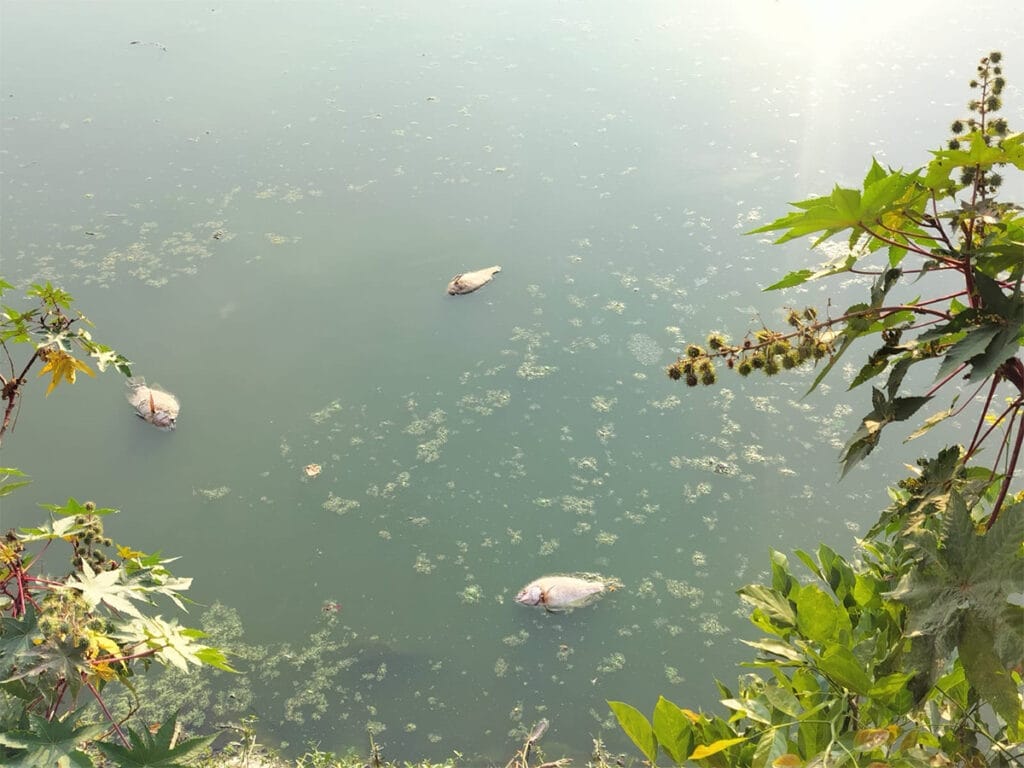
Violations ignored by authorities
At the lake’s entrance, a board installed by the Karnataka government and the CSR initiative advises against littering and prohibits eatables. Ironically, just beside the board lies a canal inlet pipe, supposed to carry excess rainwater but instead discharges sewage into Mullur Lake. Nearly all PG buildings in the area contribute to this, channeling their sewage into the canal.
When asked about the building’s wastewater management plan, one of the PG managers responds: “We let the water into the kaluve (canal) and it flows to the lake. This is what everyone on the street does.” When asked whether it was only gray water or black water as well, he declines to comment.
Another PG manager points to a drainage tank lid and says, “We have a drainage tank; you can open it and check if you want.” An outlet is still discharging wastewater into the kaluve, and she claims it’s just water from the kitchen and dining area. However, discharge of untreated sewage into the lake directly or indirectly is prohibited. A few other managers of nearby PG accommodations refused to comment.
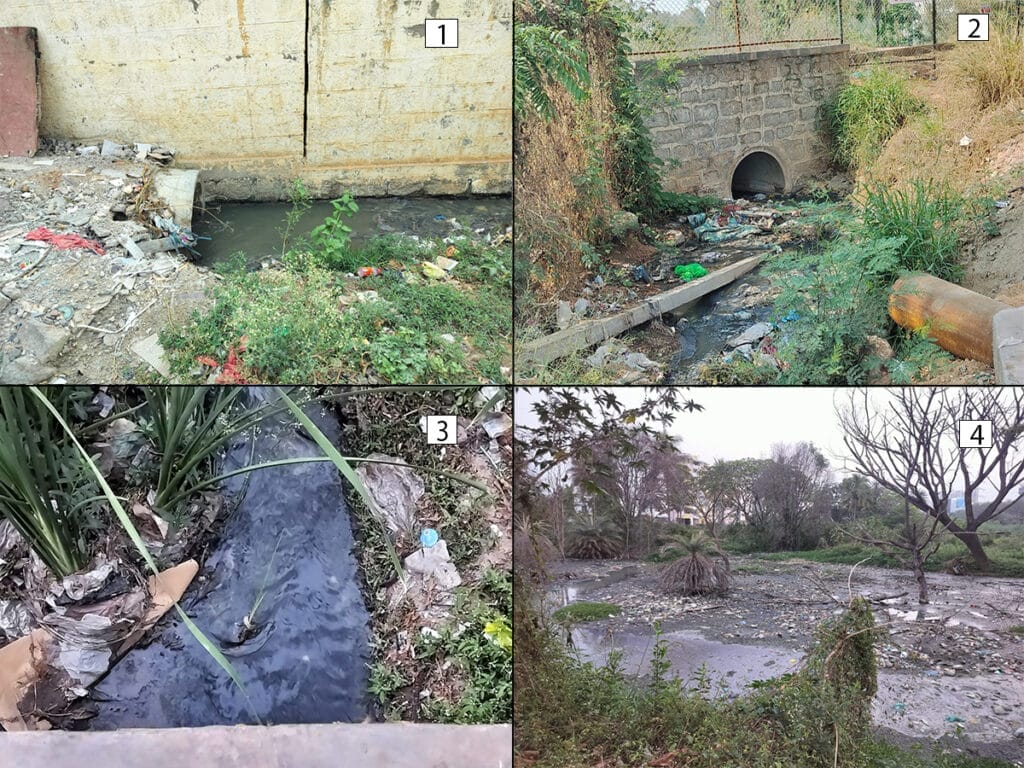
A recent amendment to guidelines mandates Sewage Treatment Plants (STPs) for commercial establishments in Bengaluru. In areas with underground drainage systems, STPs are required for buildings with a built-up area of 5,000 sq m or generating 35 kilolitres of sewage daily. In Kodathi panchayat, which lacks underground drainage, STPs are mandatory for establishments with a built-up area of 2,000 sq m or more.
Read more: Why Bengaluru must preserve and restore its lakes
Complaints by lake activists didn’t help
Chetan Gopal, a lake conservationist, with a few other residents, raised concerns with Deputy Chief Minister D K Shivakumar a year ago. Following this, the panchayat removed the inlet pipes and blocked sewage entry. However, the PG accommodation owners undid the changes in a week, and the situation returned to its previous state.
“When we followed this up with the panchayat, they claimed that these PG accommodations are illegal constructions, and so notices would be sent out and the Bangalore Electricity Supply Company (BESCOM) would cut their electricity supply. But no action was taken,” Chetan says. When Citizen Matters spoke to a few PG accommodation managers, they confirmed that they had never received any complaints/notices from the authorities.
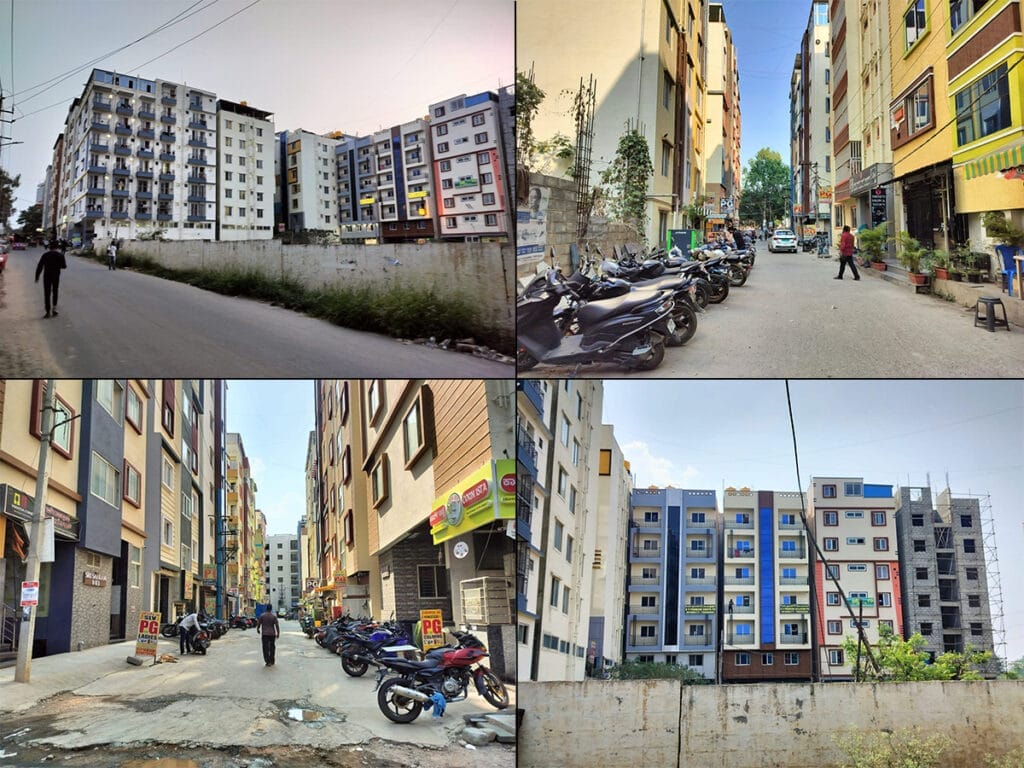
“Similarly, behind RGA Tech Park, there are many illegal constructions. Earlier, sewage was collected elsewhere. But after a new stormwater drain was built from behind the tech park to the lake, all the sewage was diverted to this lake,” Chetan adds. This is not an isolated issue. Sewage contamination is a major problem in 14 other lakes in the region.
Jurisdictional issues
Considering Mullur Lake is just outside city limits, jurisdictional issues abound, and no agency is taking responsibility for the lake’s upkeep. The Karnataka State Pollution Control Board (KSPCB) monitors water quality in 116 lakes, but Mullur Lake is not one of them. Located about 100 metres outside Bruhat Bangalore Mahanagara Palike (BBMP) limits, Mullur Lake channels excess water into Chikkabellandur Lake, which falls under BBMP jurisdiction.
BBMP has now allocated ₹10 crores for Chikkabellandur Lake’s rejuvenation. Chetan proposes installing diversion channels for both lakes and extending BBMP’s underground drainage network beyond its limits.
The BBMP, Forest Department, Bangalore Development Authority (BDA) and Bangalore Metro Rail Corporation Limited (BMRCL) take custody of different lakes in Bengaluru. But Mullur Lake is not under any of these custodians. This means the civic authority, the panchayat, is responsible for ensuring encroachments are cleared, the lake is rejuvenated and maintained.
Lack of funds and initiative
Muralidhar P, Kodathi Panchayat Development Officer, says that the PG owners have not taken any permission for the construction. “We have issued notices to them and have requested the BDA and KSPCB to take necessary actions, as they have the power to do it. But no actions have been taken so far,” Muralidhar adds.
Following concerns raised by residents, the panchayat has developed a Detailed Project Report (DPR) for around ₹7 crores to install an STP in Mullur Lake. “We are looking for funds for setting up the STP. Unlike BBMP lakes, we do not have dedicated funds to rejuvenate lakes. So, the State government’s assistance or corporate funds are needed to take up this project.”
The panchayat also seeks NGO support for monthly lake clean-ups. While measures are being taken now, Chetan criticises authorities for failing to prevent illegal construction earlier.
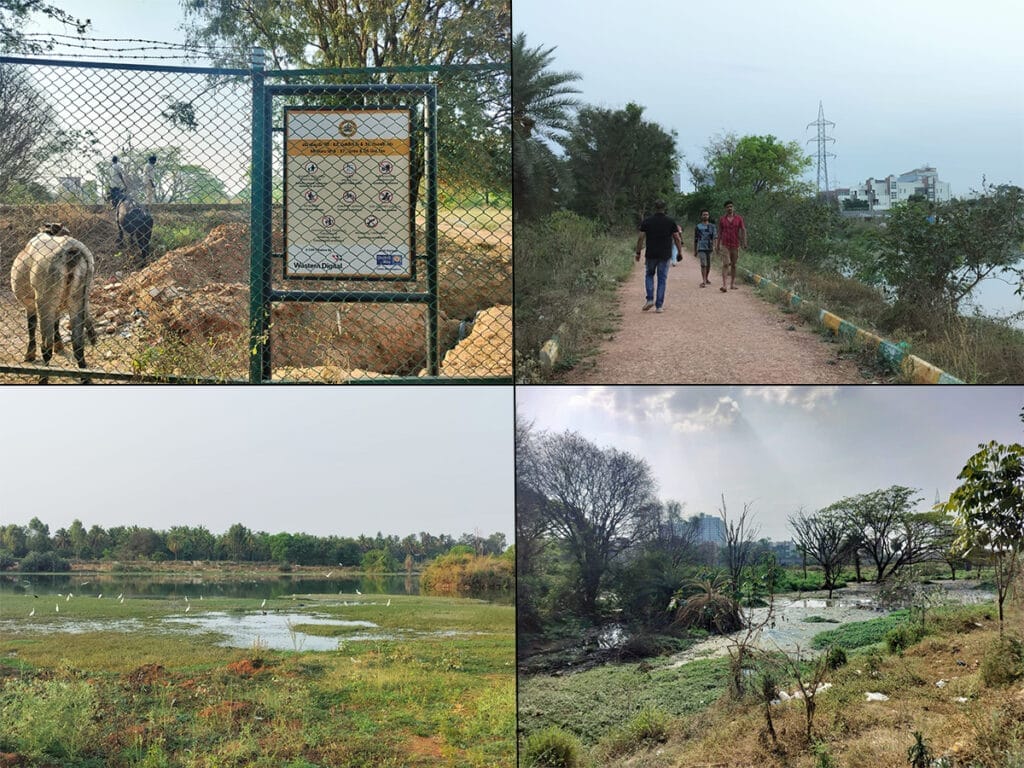
Read more: Saving Bengaluru’s lakes: How citizen audits protect ecosystem assets
Encroachments in the lake
The lake is also plagued by encroachments. According to the Revised Master Plan, 2015, by the BDA, a 30-metre buffer zone must be maintained around all water bodies, prohibiting any construction within this area. However, some constructions encroach directly into the lake’s boundary, while many others violate the 30 to 75-metre buffer zone recommended by the National Green Tribunal. Muralidhar states that the Tahsildar is aware of these encroachments.
According to T V Ramachandra, scientist and researcher at the Centre for Ecological Sciences, Indian Institute of Science (IISc), more greening must be taken up in the buffer zone. While saplings have been planted and are growing in the lake periphery, citizens complain that there is no maintenance.
Ramachandra highlights that these illegal constructions should pay for the damage caused as per the “polluter pays” principle outlined by conservationists and Indian environmental laws.
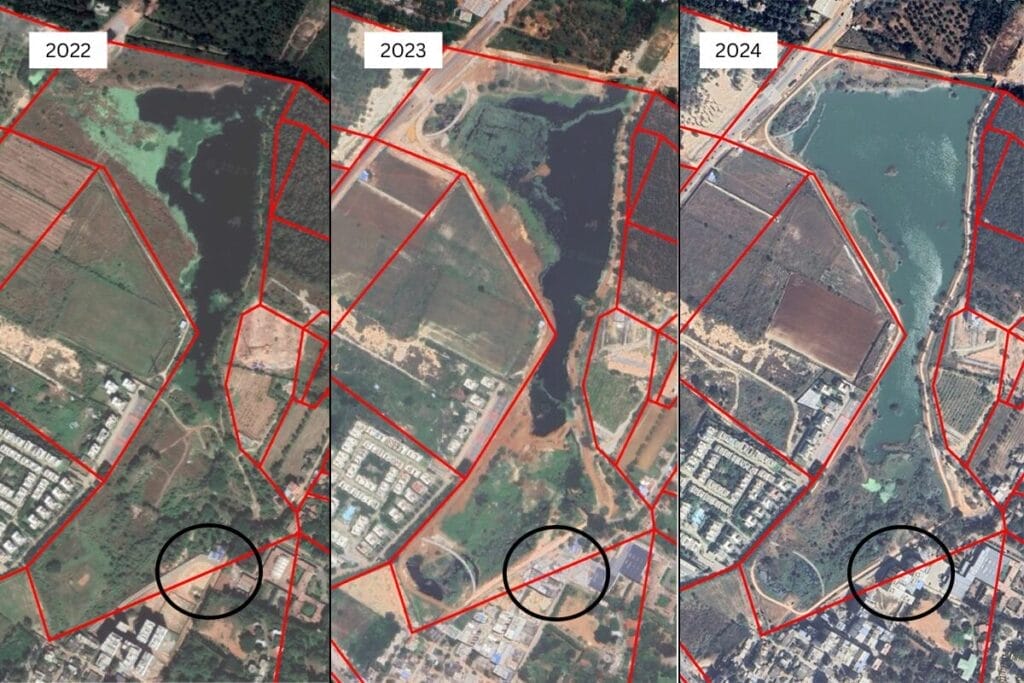
What could be the consequences?
Ramachandra emphasised that discharging sewage into lakes would severely impact groundwater quality. While the water in the city’s lakes is not potable, one of the primary functions of these lakes is groundwater recharge. Sewage mixing into groundwater could release cancer-causing pollutants, along with harmful pathogens that pose serious health risks. Additionally, the influx of sewage promotes the growth of invasive species like water hyacinth, disrupting the aquatic ecosystem.
While lakes like Mullur are losing capacity to sewage water, BWSSB is spending crores to fill lakes with treated water from apartments. While a few lakes suffer from neglect, others receive only superficial fixes. “The government must prioritise preventing pollution before implementing ad-hoc fixes,” Ramachandra says.
Demands for Mullur Lake
- Proper silt trap, debris trap and diversion channel at all three existing inlets.
- Develop a constructed wetland and an STP.
- Clean and maintain the lake and clear encroachments.
- All PG owners to buy land, should setup STP and treat their sewage.
- UGD to be planned and connected to the BWSSB network in areas outside the BBMP jurisdiction.
- KSPCB must monitor the water quality of the Mullur Lake and other lakes that are outside the BBMP limits.
Well done Gangadharan.Keep it up
Very good reporting. Hope it creates an awareness on an alarming issue.